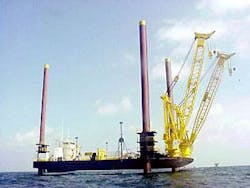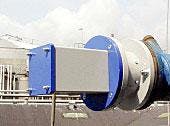200 ft class lift boat added to gulf fleet
Elevating Boats LLC has added a 200 ft class lift boat to its Gulf of Mexico fleet.
The Mammoth Elevator has 200 ft of leg and can operate in water as deep as 160 ft and as shallow as 8 ft.
Its deck and living quarters arrangement provide a timber-covered open deck area of about 5,800 sq ft. A streamlined hull form, recessed propellers, and 1,080 hp for the main engines provide a forward speed of 7 knots while minimizing fuel consumption.
Maximum deck cargo that the vessel can elevate is 600,000 lb.
The lift boat is equipped with two LC400 cranes capable of lifting API 2C static lifts of near 200 tons each. One of the cranes is equipped with a 150 ft long boom for extended-reach lifts. The two cranes may be used in tandem to make API 2C dynamic lifts of more than 500,000 lb.
Crane hydraulic power is supplied by four Caterpillar Inc. main engines utilizing a four-way redundant, open-loop hydraulic system.
The vessel has living accommodations for 8 crew members and 36 offshore workers. There is a 21 seat galley, recreation-lounge area, and safety meeting-muster area provided for the comfort of personnel on board. Accommodations are largely below deck along the sides of the vessel.
A 270 hp, recessed tunnel bow thruster is provided to assist vessel maneuvering.
Source: Elevating Boats LLC, Houma Div., 201 Dean Court, Houma, LA 70363.
Free brochure features open hopper pump
A new type of open hopper pump to mix and transport viscous products and dewatered sludge cake is featured in a brochure that's free for the asking.
The BTEI pump has been used to mix coal with sludge cake to feed to incinerators and boilers. It can also be used to mix CaO with biosolids to meet EPA land application requirements.
The new design utilizes a ribbon-screw feed auger and bridge-breakers with an independent variable speed drive. This allows the bridge-breaker to operate at a speed that is independent from the pump speed. The design enhances mixing and separates the fluid shearing action from the pumping rate. It also reduces bridging of product above the entrance to the pumping elements.
Source: seepex Inc., 511 Speedway Drive, Enon, OH 45323.
Improved polymer for water-base muds
Improved synthetic polymer D-178 Plus is available for high temperature, high pressure drilling, completion, and workover fluids.
The improved polymer imparts stable HTHP fluid loss control and viscosity to fluids that have exceeded the thermal stability limits of commonly used natural polymers such as polyanionic cellulose (PAC), carboxymethylcellulose, and starch. Test data demonstrate the utility of the polymer in muds formulated with seawater, sodium chloride brine, potassium chloride brine, and potassium formate brine. Depending on the system in which it is tested, the thermal stability limit of the D-178 polymer is 375-400° F. as tested in the laboratory. Field use typically allows polymers to be used with bottom hole temperature (BHT) exceeding maximum laboratory temperature stability by 25-50° F.
The company says that experience indicates the most economical drilling fluid program for HTHP wells is to formulate the mud with PAC in the upper sections of the well and drill ahead until the BHT becomes high enough that the PAC polymer consumption begins to increase as a result of thermal degradation. At this point, switching to D-178 Plus will give a relatively seamless transition to a mud that is thermally stable to about 400° F.
Source: Drilling Specialties Co. LLC Div., Chevron Phillips Chemical Co. LP, 10001 Six Pines Drive, The Woodlands, TX 77380.
High temperature flowmeter
The new IR4 gas velocity monitor combines infrared absorption, time of flight, and cross correlation of infrared signatures to handle difficult applications.
It is suited for areas of high temperatures, high dust, high moisture, and-or corrosive gas composition. The IR4 allows engineers to monitor temperatures as high as 2,200° F.
Source: E Instruments Group LLC, 127 Walters Ave., Trenton, NJ 08638.



